
Between Echoes is an exhibition that invites us to question and reflect on sustainability, the climate crisis and our collective responsibility; it proposes an encounter in which the public is confronted with the complexity of our relationship with the environment. Between Echoes does not seek definitive answers, but rather to inspire an open and constantly evolving dialogue, challenging the viewer to explore layers of meaning, creating a space for contemplation and dissent. Thus, Between Echoes is a call to rethink and redefine our intrinsic connection to nature, an echo that resonates beyond the gallery.
Within the framework of the exhibition, talks on the environmental situation in Colombia will be held in collaboration with the foundation, Global Warning Agency (GWA).
Montenegro Art Projects is an art gallery that generates multicultural dialogues between established and emerging artists with exhibition projects that question our perspective as a society. The gallery's projects debate on migratory and environmental phenomena, freedom of expression or the role of women in art.
Founded in 2011 in Miami, Florida; MAP designs experiences through art, such as events, trips and art tours. In 2021, the gallery opened its new exhibition space at Parque de la 93 in Bogota, where it carries out its exhibition program.
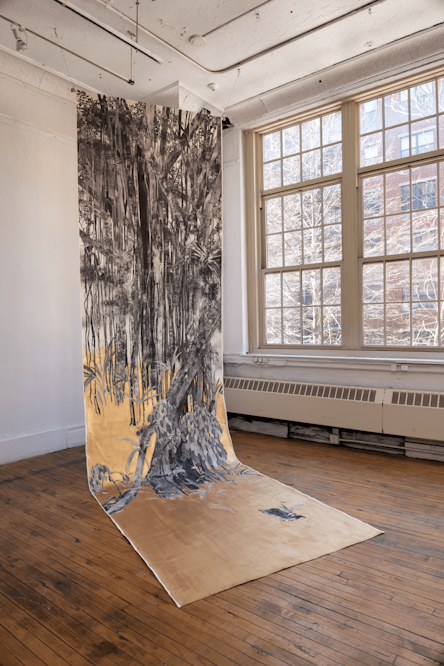
Tatiana Arocha (New York, 1974) is a Colombian artist born in New York who works and lives in Brooklyn. Her artistic practice explores the intimacy between people and the land, rooted in her personal memory and her immigrant experience with an emphasis on community, through public interventions and the exchange of knowledge. In most cases, Arocha’s works enliven and reconstruct the vulnerable rainforests of her homeland, confronting the ecological, emotional, and cultural loss caused by extractive economies and colonial practices. By intertwining historical and contemporary technologies, Arocha’s unconventional process and craftsmanship express her complex relationship with nature and culture´s transformation.

Alejandro Tobón (Medellín, 1978) reflects on the historical processes of colonization and annihilation that transform the relationship with the land. Thus, this work questions the dynamics under which the territory acquired mercantile characteristics and, in spite of being a common natural element, is a common natural element, it is distributed in a systematic and fragmented way. Making use of geometric and organic forms, with constructive principles of craftsmanship, architecture and industry, Tobón creates a form and surface that occupies a place and invites the viewer to interact, generating effects and routes, effects and paths that show the human presence on the territory.

Eduard Moreno (Bogotá, 1975). With an introspective gaze towards his origin and his environment, Eduard Moreno's work is intertwined with personal and public concerns. His exploration of the liminal place manifests itself in the notion of the archive, plastically revealing the complexity of his experience. In response to the climate crisis, his work Paisaje Entrópico I and II addresses the increasing frequency of forest fires in Colombia. Through images captured during these events and the use of collected ashes from Bogota´s Cerros Orientales mountains, the series reflects the devastating reality of the entropic landscape, highlighting the urgency of addressing atmospheric disturbances and their consequences.

Juan Carlos Zaldivar (Cuba, 1967) is a multidisciplinary artist based between Miami and Buffalo (NY). His work explores the physical and the perceptual transformation through film and visual projects. Inspired by Both dance and time-lapse animation, his work reflects the tension between subjective reality and actuality. Zaldivar challenges the dichotomy between the real and the perceived through the use of elements such as light, sound and kinetics. With a focus on the relationship between nature and artificial constructions, his work generates dialogues on identity, history and transculturalism. Using humor, loose narratives and a respect for the invisible, he creates installations that invite reflection on our connection to the environment. Juan Carlos Zaldivar stands at the crossroads of the tangible and the intangible, challenging conventional notions of reality through a unique and captivating artistic expression.
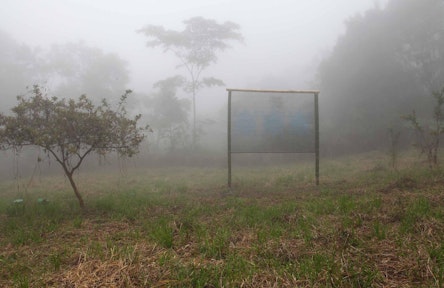
Andrea Marin (Bogota, 1989) Her work is immersed in the deep exploration of human habitation and its interaction with the natural environment. Her approaches are imbued with a fundamental question about our existence in the world, expressed through the act of inhabiting. From this perspective, her work becomes a dialogue between human beings and their environment, exploring the intersection between culture and nature. Her work gestures becomes an invitation to the viewer to reflect on the dynamic relationship between culture and nature, highlighting the importance of preserving the harmony between the two for a sustainable future.
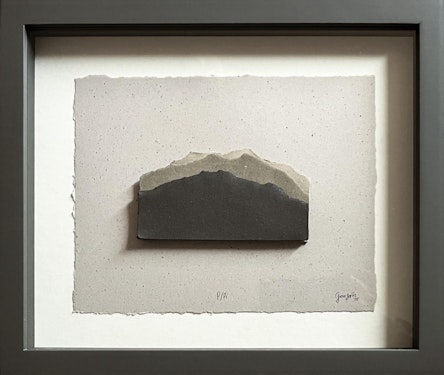
Hector Garzón (Montería, 1993). His work stems from a deep fascination and admiration for nature and the elements that compose it. His work Paisajes Desérticos (Desert Landscapes) emerges as a visual representation of data on deforestation in Colombia from 2002 to 2022. Using bar graphs as inspiration, Garzón turns this data into ceramic landscapes, reflecting the reality of our territory in desert earth tones. Each work is unique but together it offers a panoramic view of the evolution of deforestation in the country.
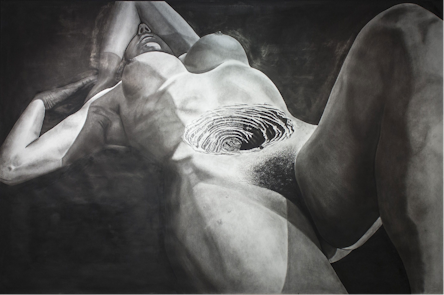
Camilo Bojacá (Sogamoso, 1985) presents Vulnus, a project in which the naked and defenseless body of the woman is a symbol of the conquered, excavated and violated territory. The body is then the scene of depredation, it´s the landscape domesticated through the transforming force of the machine, which imposes itself in a clear exercise of power. These territories suffer from the large-scale intervention that we humans carry out. The wound (Vulnus) is the trace of the intervention on that body-territory, it´s the sign of the biopolitics that domesticates and alters it. Thus, the struggles and resistances from the body, are none other than those of the territories to stay alive and stable, thus understanding itself as part of a symbiotic system.

Tatiana Arocha (New York, 1974) is a Colombian artist born in New York who works and lives in Brooklyn. Her artistic practice explores the intimacy between people and the land, rooted in her personal memory and her immigrant experience with an emphasis on community, through public interventions and the exchange of knowledge. In most cases, Arocha’s works enliven and reconstruct the vulnerable rainforests of her homeland, confronting the ecological, emotional, and cultural loss caused by extractive economies and colonial practices. By intertwining historical and contemporary technologies, Arocha’s unconventional process and craftsmanship express her complex relationship with nature and culture´s transformation.
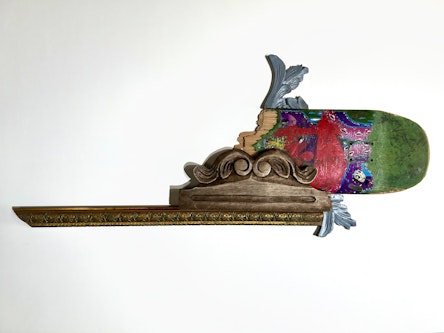
Alejandro Tobón (Medellín, 1978) reflects on the historical processes of colonization and annihilation that transform the relationship with the land. Thus, this work questions the dynamics under which the territory acquired mercantile characteristics and, in spite of being a common natural element, is a common natural element, it is distributed in a systematic and fragmented way. Making use of geometric and organic forms, with constructive principles of craftsmanship, architecture and industry, Tobón creates a form and surface that occupies a place and invites the viewer to interact, generating effects and routes, effects and paths that show the human presence on the territory.

Andrea Marin (Bogota, 1989) Her work is immersed in the deep exploration of human habitation and its interaction with the natural environment. Her approaches are imbued with a fundamental question about our existence in the world, expressed through the act of inhabiting. From this perspective, her work becomes a dialogue between human beings and their environment, exploring the intersection between culture and nature. Her work gestures becomes an invitation to the viewer to reflect on the dynamic relationship between culture and nature, highlighting the importance of preserving the harmony between the two for a sustainable future.

Tatiana Arocha (New York, 1974) is a Colombian artist born in New York who works and lives in Brooklyn. Her artistic practice explores the intimacy between people and the land, rooted in her personal memory and her immigrant experience with an emphasis on community, through public interventions and the exchange of knowledge. In most cases, Arocha’s works enliven and reconstruct the vulnerable rainforests of her homeland, confronting the ecological, emotional, and cultural loss caused by extractive economies and colonial practices. By intertwining historical and contemporary technologies, Arocha’s unconventional process and craftsmanship express her complex relationship with nature and culture´s transformation.

Alejandro Tobón (Medellín, 1978) reflects on the historical processes of colonization and annihilation that transform the relationship with the land. Thus, this work questions the dynamics under which the territory acquired mercantile characteristics and, in spite of being a common natural element, is a common natural element, it is distributed in a systematic and fragmented way. Making use of geometric and organic forms, with constructive principles of craftsmanship, architecture and industry, Tobón creates a form and surface that occupies a place and invites the viewer to interact, generating effects and routes, effects and paths that show the human presence on the territory.
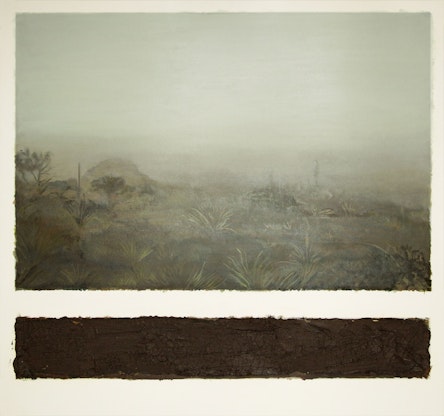
Eduard Moreno (Bogotá, 1975). With an introspective gaze towards his origin and his environment, Eduard Moreno's work is intertwined with personal and public concerns. His exploration of the liminal place manifests itself in the notion of the archive, plastically revealing the complexity of his experience. In response to the climate crisis, his work Paisaje Entrópico I and II addresses the increasing frequency of forest fires in Colombia. Through images captured during these events and the use of collected ashes from Bogota´s Cerros Orientales mountains, the series reflects the devastating reality of the entropic landscape, highlighting the urgency of addressing atmospheric disturbances and their consequences.
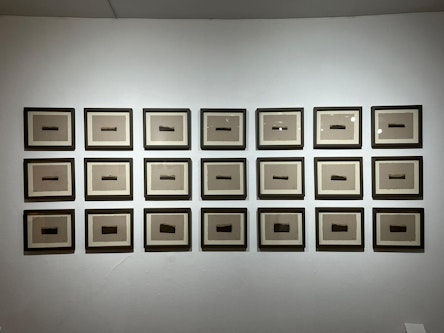
Hector Garzón (Montería, 1993). His work stems from a deep fascination and admiration for nature and the elements that compose it. His work Paisajes Desérticos (Desert Landscapes) emerges as a visual representation of data on deforestation in Colombia from 2002 to 2022. Using bar graphs as inspiration, Garzón turns this data into ceramic landscapes, reflecting the reality of our territory in desert earth tones. Each work is unique but together it offers a panoramic view of the evolution of deforestation in the country.